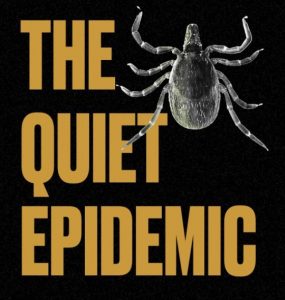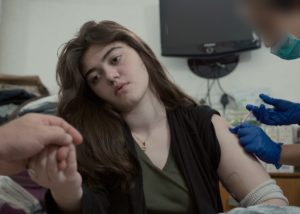I recently took time out of my schedule to watch a movie, one I’d heard about but not seen, one that deals with an issue I have advocated and educated for over 39 years.
After four decades, people ask me why I continue to volunteer for the Lyme disease cause. This movie lays it out. My life flashed before my eyes, emotions tore at my heart─ anger and sadness─ and brought me to tears.
“The Quiet Epidemic” is a journey through the often times sordid history of Lyme to the present through the words and deeds of some of the most competent and giving scientists and doctors in the Lyme movement, including doctors Brian Fallon, Rich Horowitz, Ken Liegner, and others too numerous to mention.
The real science

How real is it? The movie was interspersed with the life struggle of Julia from preteen onward. She lost the ability to walk, to dance, to play sports, and to do the things ordinary children do on their trip through their formative years before having to take on the responsibilities of adulthood.
I have met Julia and her family and thousands of others like them, struggling not just with Lyme disease but with the ridicule, scorn, and trashing from the elites of medicine whose words and deeds have compromised the abilities of the doctors in the trenches to do what they went to medical school to do—use their knowledge and instincts to make patients better—not to produce and sell corrupted science that enables them to rob legitimate researchers of grants—researchers trying to find a cure for chronic Lyme disease.
A dogmatic approach
The medical community has failed Lyme patients. They did so by adopting a dogmatic approach to Lyme that created an environment where hundreds of thousands of people, if not millions, heard, “there is nothing wrong with you.”
If enough people tell you there is nothing wrong, eventually you say, maybe it is not Lyme disease. That perception was communicated to higher levels of government and funding agencies.
Working with the medical establishment, who have a network of “journalists” and “news writers” working to censor the real science of chronic Lyme. These officials often leave their government jobs to take positions in big pharma, pushing products−not necessarily ones to help chronic Lyme patients− who are left to their own devices, except for the lucky ones who have support from family and friends.
Patients often lose the ability to work or to attend school and often become permanently disabled. Sometimes they die from Lyme disease, although even in death, Lyme is often denied as the responsible culprit. Yet in 2008 in a Washington DC meeting, a former NIH Lyme official stated that Congress didn’t need to worry about additional Lyme research, because the science had already been done, and they knew what they needed to know.
How do I know chronic Lyme is real?
In a time of 24-hour fake news, how do I know chronic Lyme is real? I have lived it with my family, with friends, with Lyme patients across the country. I have witnessed them being called “Lyme loonies” in major media, been told they are conspiracy theorists, the disease is in their heads.
From babies to students to workers in all professions, they have all been marginalized. Somewhere along the line, however, it becomes difficult to “spin” away some people. The movie’s example of Dr. Neil Spector is one of those instances. I met and spoke with Neil on a number of occasions, and early on we spoke about applying some of those cancer breakthroughs to chronic Lyme.
He suffered from undiagnosed Lyme for many years and went from being a marathon runner to someone who could barely walk 20 yards, eventually and literally losing his heart to the disease.
Articulating the truth
Dr. Spector understood and articulated the truths about chronic Lyme and recognized the bias of some of his own medical profession in blaming patients instead of curing them. I cried when he died and again in the movie when he appeared at the end not too long before his death.

I know almost all of the good people in the movie. And I know and/or recognized, not in a positive way, the ones who have denied the existence of a disease and contributed to the suffering of those with it.
I fumed along with Julia’s dad as he received a call from a government public health agency telling him not to listen to the information out there on chronic Lyme.
It dredged up memories of my 45-minute call to that same agency in the early 90s telling−actually yelling at them─ that I would sue them for what they did with a study I had helped to precipitate on children here in New Jersey schools with chronic Lyme who were sick and unable to receive appropriate education or even acceptance as sick.
Instead of formally publishing the Lyme study, although they wrote up the findings, they did a spin-off study of children who were seizing in the hospital here for weeks and months, children whose parents I was trying to help.
What they did with that study is unspeakable, and in my opinion, was done to prevent patients from being treated─ thus the yelling on the phone as I stated that to them. They did send me a letter subsequently saying that was not the purpose of the study, but the letter was and is not worth the paper it was printed on. I learned from that experience that US public health is an oxymoron where Lyme disease is concerned.
Channeling the anger
Angry as I had been for those sick children and parents then, I did not know at the time that my daughter with chronic Lyme would subsequently suffer temporal lobe seizures for three years straight and be out of school four full years and two partial years. During that time, I decided to channel that anger and to extend the decade of Lyme advocacy I had already embraced and make Lyme my life’s work.
So mother of three then, grandmother of four now, I watched this movie and am pleased that it clearly and accurately presented the science, vindicated patient suffering, and provided in my opinion, an ugly glimpse of some whose greed and bias have, almost five decades into Lyme disease, precluded a cure for Lyme and caused untold millions to suffer the agonies of Lyme.
Let’s hope the public consciousness is raised enough by this movie to demand those responsible to be held accountable.
Click here to learn more about “The Quiet Epidemic.”
Pat Smith, President of the Lyme Disease Association, has served two terms on the federal Tick-Borne Disease Working Group and has testified before Congress about Lyme disease. She has helped write legislation, organized educational conferences and spoken widely on the topic of tick-borne diseases.





















We invite you to comment on our Facebook page.
Visit LymeDisease.org Facebook Page